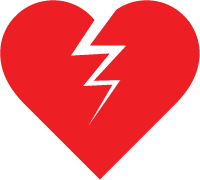
“Doctor, I feel like a fist is going through my heart”, is an expression we often hear.

Several Causes Are Possible
Not all thoracic pains are necessarily related to the heart.

Sometimes, No Obvious Cause Can Be Found
The majority of chest pains often have no identifiable source. We need to be sure that the heart is not the cause.
If you are worried about chest pain, tell your doctor.

What Is Angina?
The word angina is often used to describe heart-related chest pain.
By definition, angina means pain, and this pain comes from a variety of sources.
Let’s take a look at why the heart muscle could be responsible for this chest discomfort, commonly known as angina.
The Heart Needs Oxygen
The heart is a muscle that runs on oxygen. Oxygen is delivered by red bloodBlood is composed of red blood cells, white blood cells, platelets, and plasma. Red blood cells are responsible for transporting oxygen and carbon dioxide. White blood cells make up our immune defense system. Platelets contribute to blood cells. The bloodBlood is composed of red blood cells, white blood cells, platelets, and plasma. Red blood cells are responsible for transporting oxygen and carbon dioxide. White blood cells make up our immune defense system. Platelets contribute to blood vessels that supply the heart with fuel are the right and left coronary arteriesThe two coronary arteries, the right and the left, form the blood network that supplies the heart with oxygen and nutrients. They are located directly on the surface of the heart and branch into smaller vessels that.

The Left and Right Coronary Arteries
These 2 coronary arteriesThe two coronary arteries, the right and the left, form the blood network that supplies the heart with oxygen and nutrients. They are located directly on the surface of the heart and branch into smaller vessels that are located directly on the surface of the heart. They branch out through the entire cardiac muscle. The coronary arteriesThe two coronary arteries, the right and the left, form the blood network that supplies the heart with oxygen and nutrients. They are located directly on the surface of the heart and branch into smaller vessels that are the first to leave the aorta, the largest artery in the body.
Their starting point is found immediately above the aortic valveThe aortic valve is located between the left ventricule and the aorta. It is one of the four valves ot the heart. >>.

Consequence of Physical Exertion on the Heart
When we make an effort, the heart is called upon to speed up the circulation to the organs concerned. As a result, the workload of the heart is amplified, increasing its oxygen requirements.
A Balance of Oxygen “Demand and Supply” Is Required
Everything works perfectly as long as the heart’s need for oxygen is in balance with its supply.
Oxygen demand that is not adequately supported, or oxygen delivery that is not satisfactory, can cause pain in the heart muscle. This is due either to a severe shortage of red bloodBlood is composed of red blood cells, white blood cells, platelets, and plasma. Red blood cells are responsible for transporting oxygen and carbon dioxide. White blood cells make up our immune defense system. Platelets contribute to blood cells or clogged vessels.

Imbalance Brings Cardiac Pain
This lack of balance damages the heart muscle and can cause symptoms such as chest pain and severe shortness of breath.
It is for these reasons that the healthcare professional looks for a link between chest discomfort and physical exertion. He will check “how the heart is doing” by asking the patient various questions.
A Silent Suffering for Some
To further complicate explaining heart-related chest pain, some patients, often diabetic or elderly, perceive no discomfort or chest pain at all. Instead, they experience severe shortness of breath on exertion.

Most Common First Signs of Angina
Angina signs and symptoms vary greatly from one person to another.
The classic manifestation of angina is pain in the center of the chest, with heaviness, numbness in the left arm, and shortness of breath. Various combinations of pain are possible and can affect the chest, back, left arm, sometimes the right arm, shoulders, and even the jaw.

Discomfort Is Relieved By Rest, However, It Is Reproducible
It is important to remember that angina, or heart pain, is an upper-body discomfort. It occurs on exertion and is rapidly relieved by rest. However, the discomfort may recur following efforts of similar intensity.
A cardiac cause may then be suspected.

Let’s Consider Mr. Smith’s Case
When he climbs the hill near his home, this 60-year-old man experiences discomfort. The same thing happens every time: he has to stop for a while before continuing on his way.
In summary, Mr. Leclerc’s upper-body pain was quickly relieved by a rest period of less than 5 minutes but will recur during similar efforts.
These are classic heart pains, but why does he feel this pain or discomfort?
Demystifying Pain and Discomfort
Climbing a hill increases heart rate and bloodBlood is composed of red blood cells, white blood cells, platelets, and plasma. Red blood cells are responsible for transporting oxygen and carbon dioxide. White blood cells make up our immune defense system. Platelets contribute to blood pressure. This is a normal reaction to physical exertion, which accelerates circulation in the leg muscles. Normally, the heart is perfectly capable of responding to this effort.
However, if there is an obstruction in the coronary arteriesThe two coronary arteries, the right and the left, form the blood network that supplies the heart with oxygen and nutrients. They are located directly on the surface of the heart and branch into smaller vessels that that feed the heart, oxygen delivery is not done properly.
The oxygen supply will be insufficient to meet the needs of the heart, which is faced with an additional demand such as climbing a hill.
The resulting muscular pain in the heart is then felt.
The resting period lowers heart rate and bloodBlood is composed of red blood cells, white blood cells, platelets, and plasma. Red blood cells are responsible for transporting oxygen and carbon dioxide. White blood cells make up our immune defense system. Platelets contribute to blood pressure. This restores the balance between oxygen supply and demand, and the discomfort instantly disappears.

The Effect of Nitroglycerin on Angina
Nitroglycerin acts on the walls of the coronary arteriesThe two coronary arteries, the right and the left, form the blood network that supplies the heart with oxygen and nutrients. They are located directly on the surface of the heart and branch into smaller vessels that, causing them to dilate. If the source of discomfort is a clogged vessel, the resulting dilation will enlarge the diameter of the artery, compensating for the existing narrowing and improving bloodBlood is composed of red blood cells, white blood cells, platelets, and plasma. Red blood cells are responsible for transporting oxygen and carbon dioxide. White blood cells make up our immune defense system. Platelets contribute to blood circulation.
Pain in the Left Arm or Jaw
Why does a lack of oxygen to the heart often cause pain in the left arm or jaw?
Nerve fibers transmit the sensation of pain to the brain. This transmission takes place in stages.
These nerve fibers are multiple and very specific. They originate in the heart muscle and travel to the spinal cord in the spinal column. From there, they connect to the spinal cord network to inform the brain.
In the bone marrow, cardiac nerve fibers connect to the same nerves that transmit information about pain in the left arm, back, or jaw.
To visualize these different connections, imagine the pain nerve as an electrical wire connected to a multiple power bar where other wires from neighboring sources also exist.
Since the stimulation comes from this crossroads where several pain fibers converge, it is difficult for the brain to determine exactly where the pain originated.
A person experiencing an angina attack or heart attack will feel the pain coming from the chest, left arm, back, jaw, or several of these places simultaneously.
We are talking about referred pain in the arms, back, and jaw. Because each person is different, not everyone will experience these referred pains.
The Diagnosis Becomes Clearer
The medical diagnosis of angina is made by asking the patient about his chest pain.
Tests that Help Establish the Diagnosis
Certain medical tests are also used: the resting electrocardiogram (resting ECG) and the exercise electrocardiogram test, which is performed on a treadmill.
The information obtained is sometimes insufficient to pinpoint the diagnosis, i.e. to identify the cause of the pain. In such cases, the doctor will order more sophisticated tests, such as a stress echocardiogram or equivalent, or a nuclear medicine test such as stress or persantine myocardial scintigraphy.
Coronary angiography may also be performed to visualize the coronary arteriesThe two coronary arteries, the right and the left, form the blood network that supplies the heart with oxygen and nutrients. They are located directly on the surface of the heart and branch into smaller vessels that. This may be in a situation where pain is frequent and interferes with the patient’s activities, and/or where test results are inconclusive.

Coronary Heart Disease
If the diagnosis confirms that the chest discomfort is linked to a problem in the heart’s arteries, then it is indeed coronary arteryThe two coronary arteries, the right and the left, form the blood network that supplies the heart with oxygen and nutrients. They are located directly on the surface of the heart and branch into smaller vessels that disease.
Stable or Unstable
The diagnosis of coronary arteryThe two coronary arteries, the right and the left, form the blood network that supplies the heart with oxygen and nutrients. They are located directly on the surface of the heart and branch into smaller vessels that disease requires a precise definition of its stability. It can be either stable or unstable.
Stable coronary arteryThe two coronary arteries, the right and the left, form the blood network that supplies the heart with oxygen and nutrients. They are located directly on the surface of the heart and branch into smaller vessels that disease is described by chronic symptoms of chest discomfort on exertion, relieved rapidly by rest. These symptoms are reproducible, that is to say, they are predictable for a similar amount of activity.
Unstable coronary arteryThe two coronary arteries, the right and the left, form the blood network that supplies the heart with oxygen and nutrients. They are located directly on the surface of the heart and branch into smaller vessels that disease presents symptoms of recently onset chest discomfort or worsening chest discomfort. In other words, symptoms that are increasingly present during efforts of decreasing intensity.

Specific Treatment
Treatment depends on the type of coronary heart disease identified.
How to Reduce the Risk of Adverse Events
Your doctor will advise you on what to do to reduce the risk of adverse events related to coronary arteryThe two coronary arteries, the right and the left, form the blood network that supplies the heart with oxygen and nutrients. They are located directly on the surface of the heart and branch into smaller vessels that disease.
The doctor will recommend that the patient stop smoking and lose weight if need be, eat a balanced diet, exercise regularly, and monitor his bad cholesterolCholesterol is essential for the proper functioning of the human body, but it can also have harmful effects if present in excess. >> and blood pressure.
















